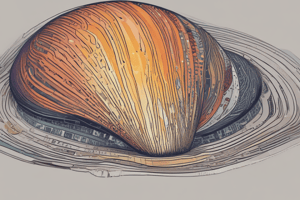Podcast
Questions and Answers
What is the primary role of the kernel in an operating system?
What is the primary role of the kernel in an operating system?
- To act as a command interpreter
- To schedule processes and manage hardware access (correct)
- To provide a graphical user interface
- To translate user commands into high-level programming languages
What distinguishes command-line shells from graphical shells?
What distinguishes command-line shells from graphical shells?
- Graphical shells only support specific operating systems
- Graphical shells can process commands faster than command-line shells
- Command-line shells provide a command-line interface, while graphical shells offer a graphical user interface (correct)
- Command-line shells require more system resources
Which of the following is NOT a type of shell mentioned?
Which of the following is NOT a type of shell mentioned?
- Graphical shell
- Korn shell
- C++ shell (correct)
- Bourne shell
What is a primary function of the shell in relation to the kernel?
What is a primary function of the shell in relation to the kernel?
How does the speed of graphical shells compare to command-line shells?
How does the speed of graphical shells compare to command-line shells?
What is a primary impact of using advanced machines on program execution time?
What is a primary impact of using advanced machines on program execution time?
Which feature is essential for ensuring efficient operation of machines?
Which feature is essential for ensuring efficient operation of machines?
Why is it important to minimize operating time in machines?
Why is it important to minimize operating time in machines?
What led to the development of operating systems?
What led to the development of operating systems?
What characteristic is necessary for modern operating systems?
What characteristic is necessary for modern operating systems?
Which of the following is NOT a feature attributed to the evolution of operating systems?
Which of the following is NOT a feature attributed to the evolution of operating systems?
How have advancements in machines affected equipment assignment to individuals?
How have advancements in machines affected equipment assignment to individuals?
In the context of operating systems, what is a critical outcome of having lesser size machines?
In the context of operating systems, what is a critical outcome of having lesser size machines?
What is an operating system primarily responsible for?
What is an operating system primarily responsible for?
Which statement best describes the role of operating systems in modern devices?
Which statement best describes the role of operating systems in modern devices?
What is the main purpose of an operating system within a computer?
What is the main purpose of an operating system within a computer?
Which of the following is not a type of project associated with operating systems?
Which of the following is not a type of project associated with operating systems?
Which operating system is commonly found in modern smartphones?
Which operating system is commonly found in modern smartphones?
How can operating systems be classified?
How can operating systems be classified?
Why is it essential for every computer to have an operating system?
Why is it essential for every computer to have an operating system?
What is one significant feature of the newest Android operating system?
What is one significant feature of the newest Android operating system?
What is the primary directive of a time-sharing operating system?
What is the primary directive of a time-sharing operating system?
Which of the following is NOT an advantage of time-sharing operating systems?
Which of the following is NOT an advantage of time-sharing operating systems?
In a multi-user operating system, what is crucial for balancing user interactions?
In a multi-user operating system, what is crucial for balancing user interactions?
What issue is predominantly associated with time-sharing operating systems?
What issue is predominantly associated with time-sharing operating systems?
How does a time-sharing operating system allocate time periods to users?
How does a time-sharing operating system allocate time periods to users?
Which of the following aspects of communication is problematic in a multi-user operating system?
Which of the following aspects of communication is problematic in a multi-user operating system?
What characteristic allows users to get quick responses in a time-sharing operating system?
What characteristic allows users to get quick responses in a time-sharing operating system?
What development trend is observed from batch systems to time-sharing systems?
What development trend is observed from batch systems to time-sharing systems?
What is one advantage of a multi-user operating system?
What is one advantage of a multi-user operating system?
Which of the following is NOT a type of operating system mentioned?
Which of the following is NOT a type of operating system mentioned?
What is a disadvantage of using a multi-user operating system?
What is a disadvantage of using a multi-user operating system?
Which operating system is known for its multitasking capabilities?
Which operating system is known for its multitasking capabilities?
In what scenario is a multi-user operating system particularly effective?
In what scenario is a multi-user operating system particularly effective?
What might be a consequence of creating multiple accounts on a single system?
What might be a consequence of creating multiple accounts on a single system?
Which operating system is likely to be designed for real-time applications?
Which operating system is likely to be designed for real-time applications?
What is a benefit of the Windows operating system mentioned?
What is a benefit of the Windows operating system mentioned?
Flashcards are hidden until you start studying
Study Notes
Operating Systems
- An operating system is the software that manages the computer's hardware resources and provides services to the user.
- It has two major components: the shell and the kernel.
- The shell acts like an interpreter between the user and the kernel, translating human commands into machine code.
Types of Shells
- Command-line shells: Provide a text-based interface for interacting with the operating system.
- Graphical shells: Provide a visual interface with icons and menus.
Kernel
- The kernel is the heart of the operating system, responsible for managing the computer's hardware resources and running programs.
- It handles scheduling, providing secure access to hardware, and executing programs.
Time-Sharing Operating Systems
- Time-sharing operating systems allow multiple users to share a single computer system.
- They aim to minimize response time by quickly switching between different programs or users.
Advantages of Time-Sharing
- Quick response: Users experience less waiting time.
- Eliminates software duplication: Users can share programs and data.
- Minimal processor idle time: The CPU is utilized efficiently.
Disadvantages of Time-Sharing
- Reliability concerns: A single user's error can affect other users.
- Security concerns: Both data and programs need enhanced protection.
- Communication issues: Efficient data exchange between users is crucial.
Multi-User Types of Operating Systems
- Allow multiple users to access and work on a single computer system, either on-site or remotely.
Advantages of Multi-User Systems
- Easy resource distribution: Users can share resources effectively.
- Extreme data backup: Essential data can be backed up securely.
- Used in libraries: Sharing of resources and data is vital.
- Eliminates disruption: Multiple users can work independently without affecting each other.
- Improved speed and efficiency: Shared resources allow for optimized performance.
- Implemented in real-time applications: Crucial for applications requiring immediate responses.
Disadvantages of Multi-User Systems
- Virus vulnerability: Multiple computers connected to a single system increase the risk of virus infection.
- Privacy and confidentiality issues: Sharing a system can compromise data privacy.
- Account creation complexities: Setting up and managing multiple accounts can be difficult.
Additional Types of Operating Systems
- Network OS: Manages resources and communication on a network.
- Multitasking OS: Allows multiple programs to run simultaneously on a single machine.
- Clustered OS: Combines multiple computers as a single system, increasing performance and reliability.
- Real-Time OS: Primarily used in systems that require immediate responses, such as robotics and industrial control.
- Linux OS: Open-source operating system.
- Mac OS: Operating system developed by Apple for its computers.
Studying That Suits You
Use AI to generate personalized quizzes and flashcards to suit your learning preferences.




